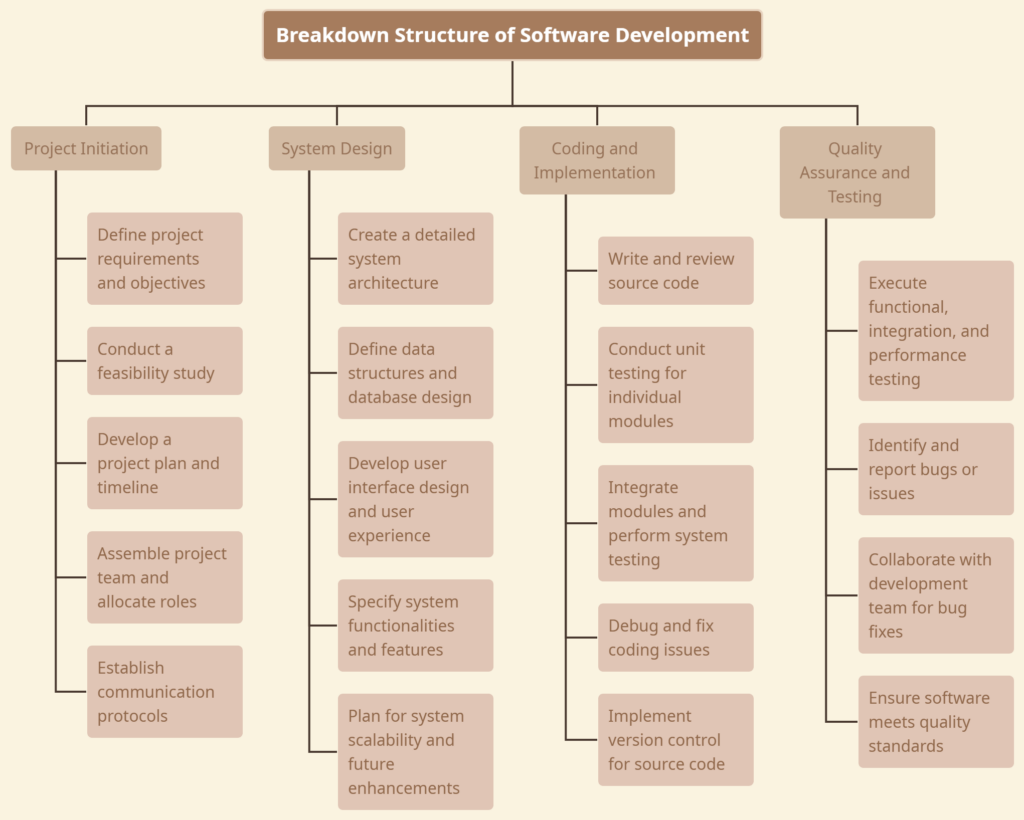
Overview of Content of Breakdown Structure
The intricacies of the Software Development Breakdown Structure come to life through this comprehensive mind map, offering an extensive view of the entire software development lifecycle. The mind map is structured into key phases, providing a detailed roadmap for successful project completion.
Project Initiation:
The initiation phase delves deeper into project elements, such as defining detailed requirements and objectives. Additionally, it explores conducting a thorough feasibility study, crafting a robust project plan with a detailed timeline, assembling a proficient project team, and allocating specific roles to ensure a cohesive workflow. Communication protocols are established to streamline information exchange.
System Design:
Moving into System Design, the mind map unfolds a myriad of elements critical to shaping the software’s architecture. It elaborates on creating a detailed system architecture, defining intricate data structures, designing the user interface for optimal user experience, specifying system functionalities and features, and planning for scalability and future enhancements.
Coding and Implementation:
The Coding and Implementation phase delves into the heart of software creation. It provides a closer look at writing and reviewing source code, conducting unit testing for individual modules, seamlessly integrating these modules for comprehensive system testing, debugging, fixing coding issues, and implementing version control to ensure a streamlined and organized development process.
Quality Assurance and Testing:
The final stage, Quality Assurance and Testing, focuses on executing multifaceted testing methodologies, including functional, integration, and performance testing. The mind map emphasizes identifying, reporting, and collaboratively resolving bugs or issues with the development team, ensuring that the software attains the highest quality standards before deployment.
Organize our Process with Breakdown Structure
Implementing a Breakdown Structure in Software Development is paramount for ensuring a systematic and well-organized approach to the complex process. The breakdown structure provides a clear and detailed roadmap, enabling teams to break down the entire software development lifecycle into manageable phases. This method enhances project management by defining project requirements, objectives, and team roles during the initiation phase. In System Design, the breakdown structure helps visualize and plan the intricate architectural components, ensuring a solid foundation for development. Coding and Implementation benefit from the breakdown structure by offering a structured approach to writing, testing, and organizing code. Quality Assurance and Testing phases are meticulously planned, identifying potential issues early on. Overall, a breakdown structure promotes transparency, collaboration, and efficiency throughout the software development journey, making it an indispensable tool for achieving successful project outcomes.
Unlock Breakdown Structure with Visual Paradigm Smart Board
Breakdown Structure unveils a transformative approach to project management, providing a structured and organized framework that significantly enhances team collaboration and efficiency. This systematic breakdown of complex tasks into manageable phases fosters clarity in understanding project requirements, facilitates effective communication, and ensures a streamlined workflow. Visual representation of each development stage empowers teams with better decision-making insights and aids in optimized resource allocation. Visual Paradigm Smart Board not only streamlines project management but also transforms it into an inspiring and collaborative endeavor, where teams can effortlessly generate, refine, and visualize their breakdown structures for enhanced productivity and success.